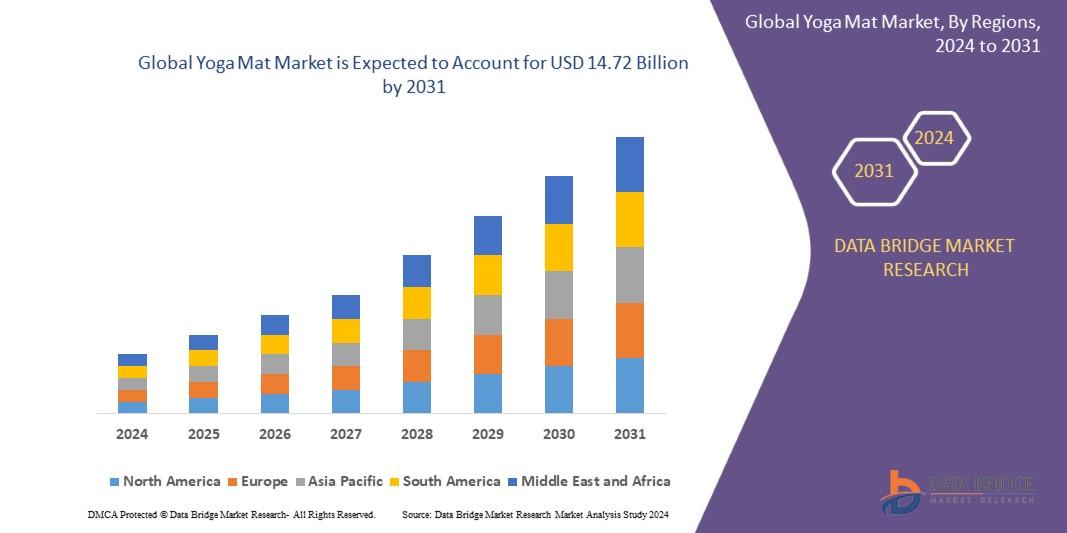The yoga mat market is expanding worldwide as health and wellness trends continue to influence consumer lifestyles.
The global yoga mat market size was valued at USD 9.53 billion in 2024 and is projected to reach USD 15.65 billion by 2032, with a CAGR of 6.40% during the forecast period of 2025 to 2032.
Growing awareness of physical fitness, rising participation in yoga and Pilates, and increasing home workout adoption have driven demand for high-quality, sustainable, and performance-oriented yoga mats. Manufacturers are responding with innovations in materials, eco-friendly production, and product differentiation to capture broader market share.
Market Overview
Yoga mats are essential accessories for yoga studios, fitness centers, and at-home practitioners. The market includes mats made from PVC, TPE, natural rubber, cork, jute, and hybrid materials. Consumers are seeking mats that balance grip, cushioning, durability, and eco-credentials. This shift toward premium and responsibly made products is influencing both price dynamics and distribution strategies.
Key channels for sales include sporting goods retailers, specialty stores, e-commerce platforms, and direct-to-consumer brand websites. The surge in digital fitness content and online yoga classes has further boosted online sales of yoga accessories.
Market Size & Share Insights
The yoga mat market’s size is increasing due to expanding participation in wellness activities and a growing middle class willing to spend on lifestyle goods. Urbanization, higher disposable incomes, and the popularity of boutique fitness studios are driving revenues in developed and emerging markets alike. Premium and eco-friendly mats are capturing an increasing share of revenue even if unit volumes skew toward lower-priced options in price-sensitive regions.
Regional dynamics matter: North America and Europe lead in per-capita spend, while Asia-Pacific—especially India, China, and Southeast Asia—shows fast growth in user base and new brand entrants.
Key Growth Drivers
-
Rising Health & Wellness Awareness: More consumers adopt yoga for stress relief, flexibility, and holistic health, increasing mat demand.
-
Shift to Eco-Friendly Materials: Demand for biodegradable or recyclable mats (natural rubber, cork, jute) is growing as sustainability becomes a purchase driver.
-
Home Fitness & Digital Classes: Online yoga subscriptions and influencer-led routines have increased first-time buyers and repeat purchases for home setups.
-
Product Innovation: Antimicrobial coatings, superior grip technology, lightweight travel mats, and thicker cushioning for joint protection are differentiators.
-
Branding & Lifestyle Positioning: Premium brands that combine aesthetics, performance, and sustainability capture higher margins and loyal customers.
Market Challenges
-
Price Sensitivity in Emerging Markets: Cost remains a barrier for premium materials in price-sensitive regions.
-
Material Tradeoffs: Eco-friendly materials sometimes compromise grip or longevity compared with traditional PVC.
-
Counterfeit & Low-Quality Imports: Proliferation of cheap mats can dilute brand perception and introduce safety issues.
-
Supply Chain Disruptions: Fluctuating raw material prices and transportation bottlenecks affect margins and lead times.
Segmentation Analysis
By Material
-
PVC
-
TPE (Thermoplastic Elastomer)
-
Natural Rubber
-
Cork & Jute
-
Others
Natural rubber and cork segments are growing fast among eco-conscious consumers, while PVC and TPE retain large volume shares due to affordability.
By Thickness / Use Case
-
Ultra-thin (travel)
-
Standard (general yoga)
-
Cushioned (therapeutic/yoga for seniors)
Different thicknesses target portability vs. joint comfort tradeoffs.
By Distribution Channel
-
Online Retail (fastest growing)
-
Specialty Sports Stores
-
Supermarkets & Hypermarkets
-
Direct Sales
E-commerce enables brands to showcase product benefits (grip tests, videos) and reach global customers.
By End User
-
Individual Consumers (home & studio)
-
Gyms & Yoga Studios
-
Corporate Wellness Programs
Individual consumers drive most purchases, but institutional clients provide B2B volume opportunities.
Competitive Landscape
Market players range from global sporting brands to niche sustainable startups. Differentiation occurs through material technology, certification (e.g., OEKO-TEX, GRS), patented grip surfaces, and lifestyle marketing. Strategic moves include collaborations with yoga influencers, subscription bundles, and eco-labeling to build trust.
Future Outlook & Forecast
Over the forecast horizon, the yoga mat market is expected to grow steadily. Key themes shaping future demand:
-
Premiumization — a larger portion of revenue from higher-priced, value-added mats.
-
Sustainability — continued shift to recyclable and natural materials, with investment in improving performance parity.
-
Customization & Direct-to-Consumer Models — bespoke prints, colors, and bundles increase lifetime customer value.
-
Expansion in Emerging Markets — rising urban incomes and fitness awareness will drive new user adoption.
-
Integration with Wellness Ecosystems — mats sold as part of wellness subscriptions, app bundles, or studio memberships.
Brands that balance performance, sustainability, and price competitiveness will capture the largest opportunities.
Browse More Reports:
Global Hybrid Imaging Market
Global Indirect Debris Removal Market
Global Integrated Labelling System Market
Global Low Emission Vehicles Market
Global Metal Carboxylate Market
Global Microcontroller for Parking Assist System Market
Global Micro-Perforated Food Packaging Market
Global Mortuary Equipment Market
Global Non-volatile Memory Express Market
Global Obesity Treatment Market
Global Ophthalmic Packaging Market
Global Organic Asphalt Modifiers Market
Global Printed Tape Market
Global Propionic Acid for Animal Feed Market
Global Rear Electric Axle (E-Axle) Market
Conclusion
The yoga mat market presents attractive growth driven by lifestyle changes, sustainability trends, and digital fitness adoption. Manufacturers and retailers that innovate in materials, invest in brand storytelling, and optimize omnichannel distribution will be best positioned to increase market share and profitability in the coming years.
Contact Us:
Data Bridge Market Research
US: +1 614 591 3140
UK: +44 845 154 9652
APAC : +653 1251 975
Email:- corporatesales@databridgemarketresearch.com
"


